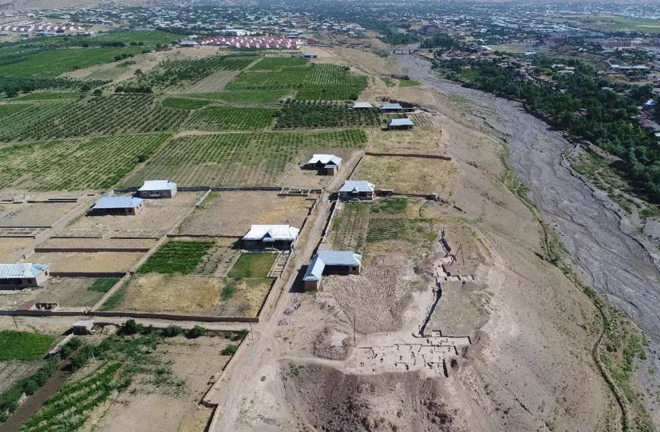Cultural Relics of Yuezhi Unearthed

The relics of Yuezhi after migration
In the 2nd century BCE, the Yuezhi, a nomadic pastoralist tribe that once dominated the Northern Steppe, was forced to settle in central Asia following their successive defeats at the hands of the Xiongnu and Wusun, thus prompting Zhang Qian’s journey to the Western Regions and the formation of the Silk Road. As an important event along the Silk Road, the migration of the Yuezhi profoundly impacted cultural communication between the East and West. The interest in Yuezhi culture remains constant among international academic circles. Nevertheless, academic agreement on the precise nature of its cultural significance, physical characteristics, as well as habitats, and other things, hasn’t yet been reached.
Northwest University professors Wang Jianxin and Liang Yun reported their discoveries and speculation from their archeological survey in Western Tianshan at the work conference of China and Uzbekistan’s joint archaeology. They contend that Rabat tomb in Bayson, southern Uzbekistan should be considered a Yuezhi cultural relic of migration. Wang and Liang also presented pictures of some of the valuable items discovered in the No. 36 tomb of Bayson, including golden belt-ornaments, glass, jade, and carnelian. It was the first time that the joint research team from China and Uzbekistan publicly released pictures of the relics.
Wang said, Northwest University’s team has conducted systematic archeological surveys, excavations and research in Gansu and Xinjiang continually since 2000 to trace and identifiy the cultural remains of the Yuezhi. At this stage, the team believes that the nomadic tribe that lived in eastern Tianshan from 500 BCE to 200 BCE might be the Yuezhi. Wang said that the examination of Yuezhi cultural relics from a period before migration needs to be complemented by examination of relics after migration. Therefore archeological projects in the north of Amu Darya in western Tianshan are needed.
In order to collect comprehensive information on the culture and agriculture of ancient nomadic lifestyles, scholars in China and Uzbekistan have conducted investigation in western Tianshan, particularly in Samarqand, Kashkardalya and Surhandalia of southern Uzbekistan since 2009. In December 2013, Northwest University signed a cooperation agreement with the Institute of Archaeology of the Uzbekistan Academy of Sciences concerning an archeological project on ancient nomadic culture in western Tianshan. A joint archeological team was formed. In August 2015, the team received special funding from the Shaanxi provincial government.
The team’s trip to the Zachan Site of Samarkand and Rabatbesson Site made great progress in this area. Liang said that the Zachan Site, located at the north foot of Zeravshan, part of Tianshan, is likely to be the remains of Kangju, an ancient kingdom in central Asia. Nearly 80 small tombs were also excavated at the Rabatbesson Site. The chronological and geographical range and cultural characteristics of this culture match documents relating to the Yuezhi after migration. Therefore it is fair to assume that the cultural relics of Yuezhi that scholars have sought for years have been found.
The excavation and identification of Rabatbesson Site are a breakthrough for future research on the Yuezhi.
Li Boqian of Peking University said that the work of Wang Jianxing and his team on Yuezhi and Kushan is reasonable and efficient in that their discovery of the ancient tribe’s distribution, cultural traits, era, culture and social conditions will also be cross-checked by relevant documents.
Zhang Weili, counselor of Chinese Embassy in Uzbekistan stated that the work conference showcased the progress the joint team made in this time. It also vividly displayed China and Uzbekistan’s achievements in cultural exchanges. Over the years, institutional cooperation such as programs involving the Institute of Archaeology, Chinese Academy of Social Sciences, Northwest University and their Uzbekistan counterparts have made remarkable achievements. Zhang also expressed gratitude on behalf of the embassy to archaeologists for their contributions in cultural exchanges of the two countries, as well as the common inheritance of humanity.
Sulaimanov, professor at Tashkent University said that the archaeological scope of Yuezhi is about 300,000 square kilometers spreading out over southeastern Uzbekistan and southwestern Tajikistan. Findings in Yuezhi research made by Wang and the joint team are encouraging.
Karlovo, an experienced Uzbekistan archaeologist, said Chinese archaeologists are admirable for their work ethic, expertise and research findings. Archaeology in general has already yielded substantial achievements, while research into the Yuezhi is just beginning, with a lot of work still to be done. Science is a truly global undertaking.
LU HANG is a correspondent with Chinese Social Sciences Today.
(edited by SUI JINGJING)
